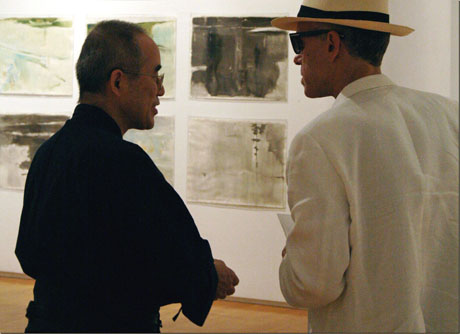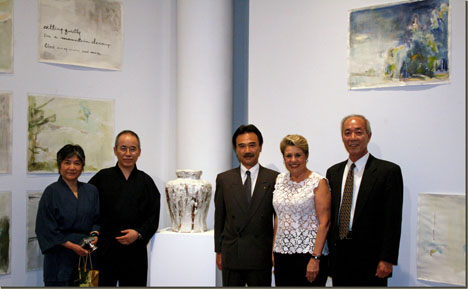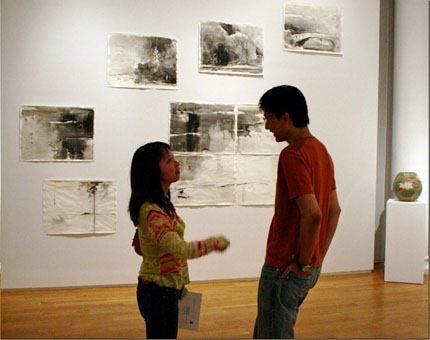This show
features the work of Tadao Okazaki a sumi-e painter who uses
mulberry paper with which to convey his fragmental abstracted
mindscapes. The ceramics of two major Japanese masters Toyoshige
Mizuno and Toshiko Nakazawa are combined with the ink paintings
of Okazaki to produce the harmonious relationship that has
always existed between these media. Furthermore, Haiku poetry
by Okazaki and also Davidson is part of this project and will
be read during the opening reception. Haiku also embellish
Okazaki’s paintings as is the custom in both Chinese
and Japanese ink work.

Mizuno with a patron at the opening reception with
sumi-e by Okazaki in the background
|

Mizuno, Oni Shino Awase Vase, 2002, 17 x
8 x 7"; behind: Okazaki, Releasing a Tune
onto the Night: Take ONe to Nine, 2006-07, 22
x 30"
|
The title of the show refers both to what the Chinese consider
the three friends meaning the pine, prunus and bamboo plants,
and to the Zen tea ceremony during whose ritual ceramics,
sumi-e and poetry played a crucial role. The difference between
the works of Nakazawa and Mizuno is that of Seto versus Rakuwares.
Seto ceramics became popular during the early feudal period
becoming elevated from utilitarian form to artistic expression
because of the trade of celadon-wares from China and Korea
and the transmission of Buddhism into Japan. Rakuwares were
rougher and thicker looking than the more delicate slipped
Setowares and were developed in the 15th century for the tea
or chanoyu ceremony meant to suggest the qualities of simplicity,
and understated elegance. Accidental effects may not have
been acceptable in China but Japanese masters were not trying
to copy Chinese ceramics instead they were incorporating interesting
elements into their native vernacular. Whereas asymmetry held
sway in Japan the opposite was true in China where balance
was the cannon. Unevenness and serendipitous effects were
greatly appreciated in Japan where the Chinese painter Xia
Kuei’s inkworks with their one corner compositions were
extensively collected.

From left to right: Mr. and Mrs. Okazaki, Mr, Mizuno,
Thalia Vrachopoulos, Rev. Okui
|
 Gallery visitors during the
opening reception
Gallery visitors during the
opening reception |
While Nakazawa creates delicate pottery that is inspired
by natural forms and in its delicacy is akin to the Setowares
of Murata Shiko, Mizuno’s work because of its accidental
effects relates more to the experimental Rakuwares of Honami
Koetsu who collaborated with Sotatsu for some of his ink paintings.
The finesse and smoothness of Nakazawa’s slips is contrasted
with the bumpy unevenness of Mizuno’s surfaces. Nakazawa’s
effects are related to Ko Setowares that exhibit a refinement
in shape, elegant decoration and a perfecting of technique
akin to Chinese Song Dynasty ceramic aesthetics. While Nakazawa’s
colors are pale shades of green gray and her textures smooth
and shiny, her shapes relate to the water lily a Buddhist
symbol of rebirth. Mizuno’s thick splatter pattern glazes,
many in crackled white the forerunner of Shino-ware produced
during the Momoyama period, result from the carefully controlled
manipulation of the oxidation process at a low kiln temperature.
The shapes of his wares relate to tea ceremony pottery such
as water jars, tea bowls, storage jars, and to floral containers.
Like the Zen ink painters before him Okazaki’s swift
brushstrokes hold only the briefest relationship to reality
and for the most part his landscapes are abstract. However
Okazaki’s paintings although may hold some tentative
relationship to the past in their use of accompanying text
are contemporary fragments that can be read individually or
collectively. Like Sesshu Toyo the greatest of Japanese ink
painters Okazaki engages in the painting of the seasons changing
our perception of the landscape from an unchanging universal
to the immediacy of the moment. Like Sesshu’s haboku
the free and broken ink landscapes of Okazaki both demonstrate
the facility of his brush as well as his embrace of the element
of fortuitous accident and suggestiveness. Few masters can
convey with ink and incredible economy the landscape’s
essence while maintaining its spirit.
According to Chinese legend one member of the three friends
the prunus is associated with early spring and new life as
well as the five clans of China. Another, the bamboo is respected
for its durability and fortitude. Finally, the pine because
it is an evergreen is known as an emblem of longevity and
is metaphorically considered the friend who remains constant
even through adversity. Like these historically important
plants and their motifs, the three arts of haiku, sumi-e and
ceramics as represented by the paintings and poetry of Okazaki,
and the ceramics of Mizuno and Nakazawa relate to Japanese
continuity but also its diversity.
|
